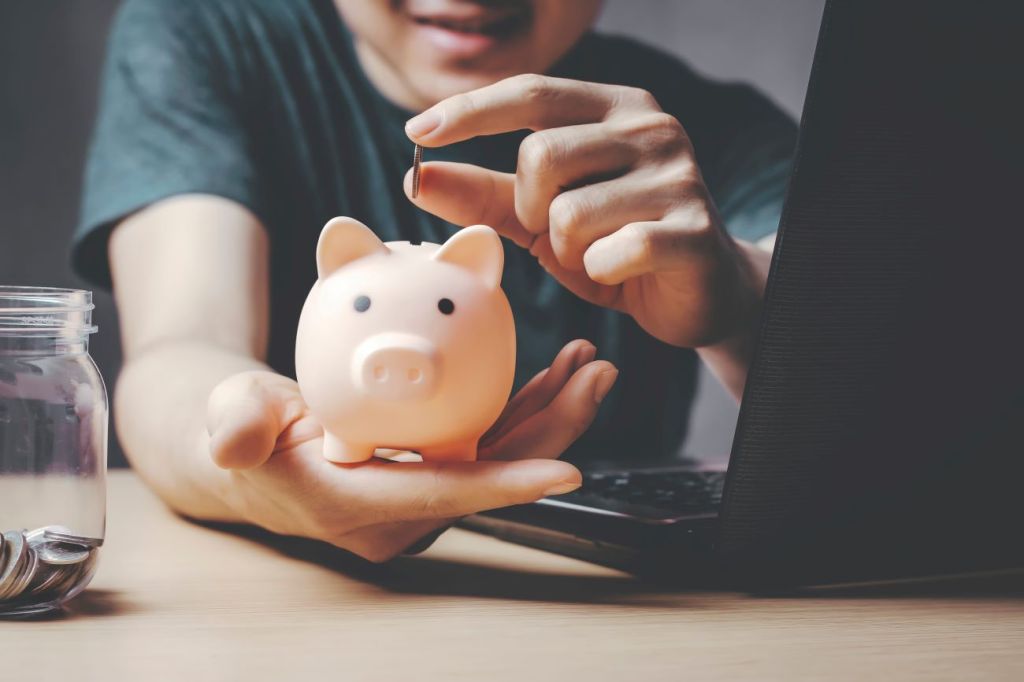Here’s the key to understanding how interest works: If you want to borrow money, you usually have to pay for it. But there’s another side of the interest coin: If you lend money (which is essentially what you’re doing when you invest or make deposits in a savings account), you can earn money, too. And watching that interest grow is a great way to motivate kids to become money-smart savers early on.
For everyone—especially new borrowers—knowing what an interest rate is and how it operates are super important. In the simplest terms, it means that when you repay money you’ve borrowed, you also pay an extra fee (interest) on top of it. Think of it as the price you pay for the privilege of borrowing. You’ll usually pay a percentage of the borrowed amount, but how lenders calculate interest depends on several key factors. More on that below.
Here are easy ways to explain how interest works to your kids—whether they’re borrowers or lenders—and the must-know info they’ll need if they apply for the most common types of loans.
Key takeaways
- Borrowed money isn’t free. It needs to be paid back—usually with a fee called interest.
- Using a credit card is like a mini-loan. If the money is paid back by the due date, there is no interest fee, but if not, you’ll need to pay interest.
- Many factors determine the interest rate on a loan, like the loan amount and term, and payment frequency.
- There are two types of mortgages: fixed and variable. Fixed-rate mortgages have the same interest rate for the entire length of the loan term. Variable-rate mortgages have interest rates that can fluctuate within the term.
- The interest rate you get on a personal loan depends on your credit score—the better your score, the better the rate could be.
- A good credit score helps determine how much money a financial institution would be willing to lend you.
How does interest work?
Understanding interest is more complicated when it comes to borrowing rather than lending, so let’s tackle that topic first.
When you’re the borrower
The first rule of borrowing: Borrowed money—whether in the form of loans, mortgages, or credit cards—isn’t free. The lender, most often a bank, charges an interest rate on the loan. That means you have to pay back the amount of money you borrowed (called the principal), plus a fee (called the interest). Typically, the borrower agrees to the lender’s fee, or interest rate, and a specific time period in which the principal and interest must be repaid in full. How the lender calculates the interest rate varies according to the type of loan.
When you’re the lender
Interest can also be earned by depositing money into a savings account. Some of these accounts require a minimum balance for you to earn interest. Your financial institution might lower your rate if your balance goes under a certain threshold, while others won’t—so it pays to read the fine print. You can also earn interest by purchasing investment products, such as stocks or mutual funds.
Read more about Interest 101 for kids: A Guide for Parents and Teens

Types of loans and interest rates
Here are five examples of how interest rates work when you are depositing or borrowing money:
How does savings account interest work?
When you deposit money into an interest-earning savings account, the bank can either lend out those funds to someone else or invest them. To do this, the bank may pay you a small interest rate (usually less than 0.5 per cent) for the privilege of using your money. That makes you the lender in this situation—even though the bank is doing the actual work of lending—so you receive the interest.
Banks usually pay interest on your savings or investment account(s) every month or every quarter. However, they often calculate the interest you earn on a daily basis using a compound interest (as opposed to a simple interest) formula. In other words, you earn interest every day on both the principal amount and the interest you’ve earned so far. And it can really stack up over time! That’s why it’s a good idea to leave earned interest in an account, so it can continue to make you more money.
Here’s an example: Say you’ve saved $2,000 and decide to put it in a savings account with a simple (not compound) interest rate of one per cent. After one year, you’d have earned $20 in interest.
If it’s in an account with monthly compound interest, however, you’d have earned $20.09. At first, that may seem like a small difference, but compound interest grows more quickly as more money is added to the balance. And watching savings stack up is a great motivator for wanting to save more.
Read more about how to open a bank account for a child.
How does credit card interest work?
Credit cards charge an annual percentage rate, or APR for short. Credit cards come with different APRs, but the most common rate in Canada is 19.99 per cent.
When you make a credit card purchase, you’re essentially taking out a mini-loan for the cost of the item or service you’re buying—unless you pay the amount off in full by the due date on your credit card statement.
Maybe you haven’t saved up the money to pay for it yet, or perhaps you’re buying something that can only be purchased using a credit card (like with a car rental company, flight, or some online retailers). Either way, you need that money up front, and your credit card company is happy to loan it to you.
But a credit card company won’t loan you the money for free indefinitely. You’ll pay interest on that purchase if you don’t pay off your card in full at the end of the billing cycle. That means the best way to use a credit card is to pay off the loan balance in full each month. But for some of us, that’s not always possible.
Let’s look at an example of how credit card interest works:
You need a new bike to get to and from school and buy one using a credit card with a 19 per cent APR. It costs $1,000, and you plan to pay $200 each month until you’ve paid off the entire debt.
After the first month, you have a balance of $800. When you multiply that balance by your daily interest rate of 0.052 per cent (you get the daily interest rate by dividing your APR of 19 per cent by 365), you can see how much interest you’re paying each day. In this case, it’s about 42 cents. In a 30-day month, you’ll pay $12.60 in interest.
On your next bill, you’d owe $812.60, thanks to interest charges. If you stick with the goal of paying off $200 every month, it will take you five more months to pay off the bike, and you’ll pay $50.33 in total interest.
You’re paying money in order to borrow that initial $1,000—so your bike ends up costing you $1,050.33.
That’s why it’s important to consider how long you’ll need to pay off a credit card purchase, then calculate the total amount your purchase will cost after the interest is factored in.
Read more about teaching kids about credit cards.
How does mortgage interest work?
A house is usually the biggest purchase people ever make. So a mortgage is likely to be the largest sum of money many people will ever borrow. Due to their scale and the fact that they are paid off over a longer time, mortgages work a bit differently than other loans.
Mortgage rates take into account a borrower’s credit score, as well as current economic conditions. Fixed-rate mortgages have the same interest rate for the entire length of the loan term, which is usually five years (though this can vary, depending on the mortgage you’ve selected).
Variable-rate mortgages have interest rates that can fluctuate, meaning borrowers may pay less in some months and more in others as rates go up and down. Variable-rate mortgages often offer lower interest rates on average, but they come with greater risk (like paying a lot more than you bargained for if the interest rate suddenly spikes).
A key piece of financial lingo you need to know is amortization. Mortgages are amortized. Say you have a fixed-rate mortgage; you pay the same amount every month, but, at the beginning of the loan period (for example, 25 years), a larger portion of those payments goes toward paying down the interest you owe, rather than the principal. This way, lenders have their fee paid off first, before borrowers begin chipping away at the principal amount they were loaned.
Read more: What is a mortgage? A guide for parents and teens.
How does personal loan interest work?
In general, there are two kinds of personal loans. The first are secured loans, which are backed by an asset, also called collateral. This collateral can be taken by the lender if you don’t keep up with your payments. An example of this would be a house or a car. The second are unsecured loans, a more common type of personal loan, which aren’t backed by an asset. Because there is no collateral, they’re riskier for banks, which means unsecured loans usually have higher interest rates.
Here’s how payments on an unsecured personal loan are determined: The loan has a fixed term (for example, three years), an amount, and an interest rate. Based on these factors, your lender will set a monthly payment. Loans with shorter terms and higher monthly repayments will lower the total cost of an unsecured personal loan.
The interest rate you get on a personal loan depends on your credit score, and is calculated as a percentage of the amount borrowed. The better your credit score, the better your interest rate could be.
Money-smart tip: This is just one more reason to be responsible when using credit—a good credit score means lenders might be willing to lend you more money and at a better rate.
How does line of credit interest work?
A line of credit lets you borrow funds up to a specific limit, in whatever amount you choose. There are a few types, both secured and unsecured, including home equity lines of credit (HELOCs), personal lines of credit, and even student lines of credit.
Lines of credit offer more flexibility than other loans, and they’re similar to credit cards in one major way: Once the borrower is approved, they have access to that set amount of money with no defined end date, and they can spend the money as needed.
However, interest rates on lines of credit are typically lower than on credit cards, and interest is only paid on the amount of money the borrower has used. Unlike a credit card, which charges users compound interest, a line of credit usually charges simple interest on the balance, meaning you only pay interest on the amount you actually borrow.

What factors affect how much interest you’ll pay?
A few key factors come into play when calculating the amount of interest you might pay, such as:
1. Loan amount
Generally, a bigger loan means paying more interest. By allowing you to borrow more funds, the lender is taking a bigger risk and therefore requires a bigger payoff for trusting you with the money.
2. Loan term
Loans are available for both short and long periods. A long-term loan will typically come with a higher interest rate. This is because economic conditions are more difficult to predict over the long term. The lender can offset this risk by charging more interest.
3. Interest rate
The higher the interest rate, the more you’ll likely pay. The interest rate on a particular loan can be affected by both your personal credit score and current economic conditions.
4. Payment frequency
Bills may seem like a monthly thing, but some loans allow you to make more frequent payments, which can cut the amount of interest you pay over time. You may also be able to pay more than the minimum required repayment amount each time, which can also chip away at the principal of the loan. If it’s in your budget, ask your lender if you can make bigger payments and/or pay more frequently.
Why kids should understand how interest works
Understanding different types of loans and the interest rates that apply to them can boost kids’ confidence when it comes time for them to make big money decisions. Awareness and education about how interest works can help them enter into loan agreements with a realistic idea about what they can expect to pay, and the real cost of the item(s) they’re buying.
Knowing exactly how their money can grow—thanks to the interest—also builds money smarts. Kids can see the value in setting aside money in a high-interest savings account or other type of investment and then become wise savers.
Read more about investing as a teenager.
How Mydoh can help you raise money-savvy teens
Teaching kids about interest basics, such as rates, terms, and the various financial products that are out there, starts them off on solid financial footing, giving them the tools to make money decisions with confidence and awareness—whether they’re the borrower or the lender. The app also empowers tweens and teens to earn money—and how to spend it wisely.
Download Mydoh today and help build the foundation of financial literacy for your kids and teenagers.
This article offers general information only and is not intended as legal, financial or other professional advice. A professional advisor should be consulted regarding your specific situation. While the information presented is believed to be factual and current, its accuracy is not guaranteed and it should not be regarded as a complete analysis of the subjects discussed. All expressions of opinion reflect the judgment of the author(s) as of the date of publication and are subject to change. No endorsement of any third parties or their advice, opinions, information, products or services is expressly given or implied by Royal Bank of Canada or its affiliates.










